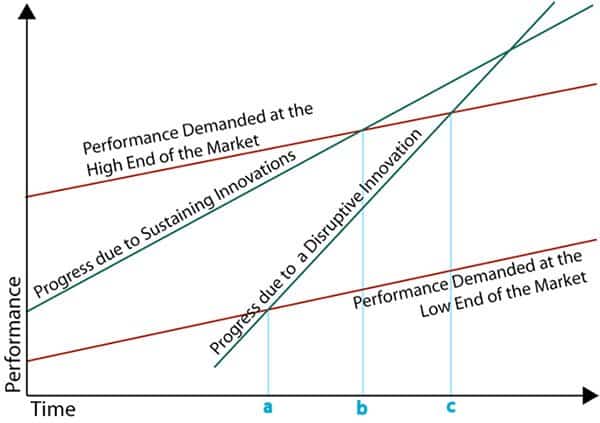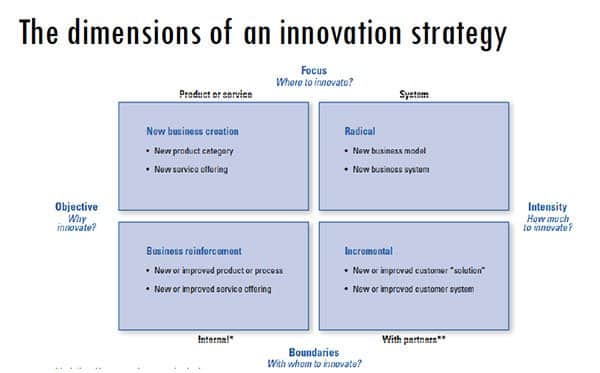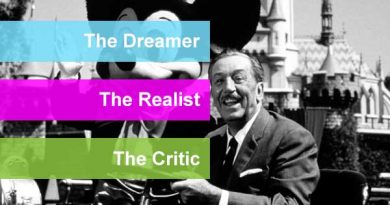Types of Innovation: The Complete Guide with Examples
Innovation is widely acknowledged as important for companies seeking market success in various industries or accessing new markets. This perception is supported by case studies and by observation of companies and their implementation of the different types of innovation as part of their organizational strategy to gain competitive advantage. In the middle of aggressive competition in a fully absorbed market, new companies find it hard to access the market without new business models that allow them to acquire a market share. There can be innovation in the business model, process, or organizational strategic thinking.
Related posts:
10 Time Management Tips to Improve Innovation
Stage-Gate: Your Guide to New Product Development Process
Creative Diversity: Doblin’s 10 Types of Innovation
What is Innovation?
Before tackling the innovation types, we need to identify what innovation is and what innovative activity is. Considered an activity, innovation is the action that is required to create new ideas, products, or services. This action leads to a positive change in the product development process and business. Hence, the definition of innovation is broad and goes beyond the product itself.
“Creating new value and/or capturing value in a new way. Value is the key word, stressing the difference between innovation and invention. The definition is simple, easy to memorize and good enough to encompass innovation in all the value chain.” ~Marc Chason Motorola Labs
The definition provided above is based on Marc Chason from Motorola Labs. Other definitions can help to clarify the innovation process, such as that provided by Victor Fernandes from Natura, who defines innovation as: “creating new value and/or capturing value in a new way. Value is the key word, stressing the difference between innovation and invention. The definition is simple, easy to memorize and good enough to encompass innovation in all the value chain.” According to another definition, innovation is changing or creating a more effective process, improved product, or service that can increase the opportunities for business model innovation. However, many use the word innovation to refer to a process rather than an outcome. Innovation refers to change, be that small or significant change. So, innovation is considered a result or an outcome of the development process that aims to achieve innovative output. To achieve innovation, companies can adopt several methods and processes, such as the stage-gate process for new product development and the double diamond design thinking process.
What are the Types of Innovation?
As mentioned above, innovation is a result of a process or activity that is reflected in the final product, service, or process. As a result, identifying the types of innovation can vary based on the target output, innovation characteristics, the process used to achieve innovation, and the scale of innovation based on its impact on the market. Different classification models have been introduced to define the types of innovation.
Innovation Based on the Organisation Structure
The first type of innovation is based on the organisational structure and where innovation contributes to the organisation. One of these categorization models was introduced by Doblin, which is based on the industry pattern and defines the types of innovation based on the following 10 types:
- Profit Model: This model involves changing how the company generates revenue (e.g. changes to pricing, margins, or new sources of revenue). For example, Amazon Prime videos introduced Freevees videos which produced a wider option of videos for subscribers with ads.
- Network: In this mode, the relationships and partnerships generate value for customers or reduce costs. Companies such as Uber and AirBnb partner with car and house owners to provide services for their consumers.
- Structure: How a company is organised or structured, such as through mergers, acquisitions, or reorganisation. Google allows employees from different departments to merge and build internal start-ups where they work together on new products, such as Google News.
- Process: This type of innovation involves improving or redesigning internal processes to make them more efficient or effective. The fast fashion companies like Zara provide a new production process that can lead to more frequent products to the market with higher revenues than the traditional model.
- Product Performance: This type of innovation involves improving the performance or features of a product or service, such as through new technology or materials. Dyson products revolutionised vacuum cleaning with their novel technology.

- Product System: This type of innovation involves developing complementary products or services that enhance the value of the original product. For example, along with Gillette Venus, there are a number of complimentary products that can provide value for consumers and extended revenues.
- Service: In this type, innovation focuses on improving the customer experience or adding new services to support the product. An example is Amazon Prime delivery, which provides quick one-day delivery.
- Channel: This type of innovation involves changing how products are distributed or sold to customers through new channels or partnerships. For instance, IKEA depends on regional partners to distribute its products in regions without branches managed directly by IKEA.
- Brand: This type of innovation involves creating a strong brand identity or image that differentiates the company or product from competitors. Virgin brand is one of the good examples that shows how the company built its products and services around one brand strategy and representation.
- Customer Engagement: This type involves improving how the company interacts with customers through personalised experiences or social media engagement. A good example is the Wii games, which allow consumers to interact physically with the game through the game console and playing tools.
This type of innovation involves improving the performance or features of a product or service, such as through new technology or materials. Dyson products revolutionised vacuum cleaning with their novel technology.
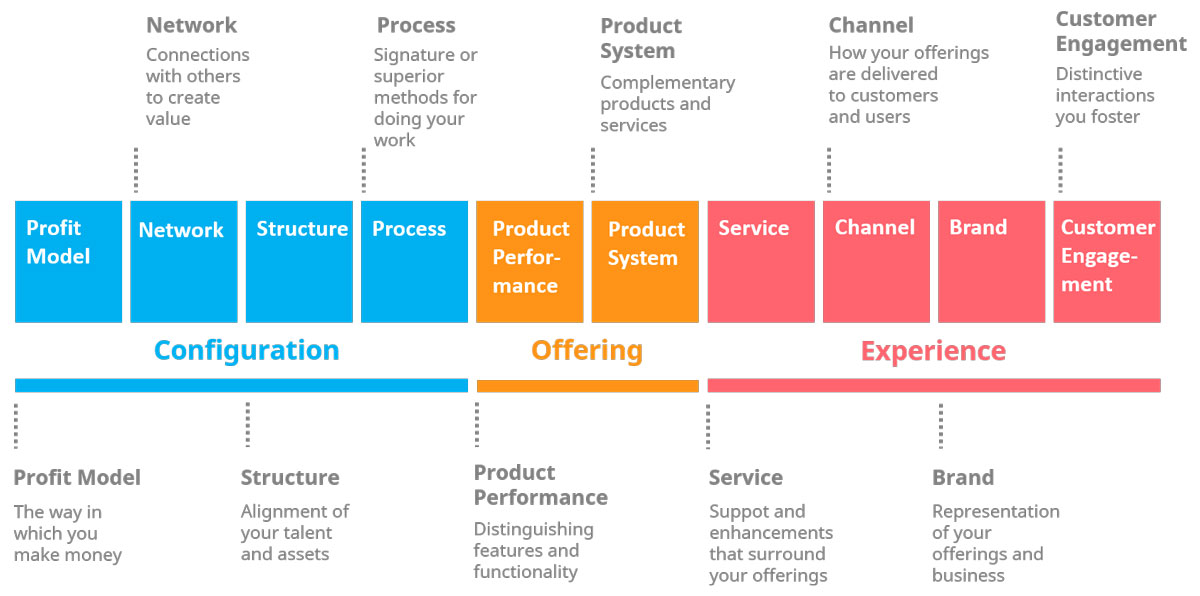
In his book, “Dealing with Darwin: How Great Companies Innovate at Every Phase of Their Evolution”, Geoffrey Moore categorised innovation based on the product and service term the consumer uses to define what they are buying. So, he defined the innovation types as the following:
- Disruptive
- Application
- Platform
- Line-extension
- Enhancement
- Marketing
- Experiential
- Value-engineering
- Integration
- Process
- Value-migration
- Organic
- Acquisition
Additionally, other models introduce other categorised models, such as the impact of current business, which categorised innovation into 1) cannibalisation, 2) market creation, and 3) competitor disruption. Another model categorises innovation based on the source of innovation to 1) manufacturers and 2) end-user innovation. The Oslo manual developed by Eurostat and the Organisation for Economic Co-operation and Development (OECD), the categorisation includes the product, process, market methods, and new organisational methods.
Types of Innovation Based on Change Impact
Aside from the categorisation models discussed above, innovation can be defined based on the change’s impact on sustaining, breakthrough, and disruption. Understanding these models help us to explore the different types of innovation and where to innovate inside the organization. The model includes three main types of innovation:
Sustaining Innovation
In this model (also known as incremental innovation), the innovation isn’t meant to introduce a fully new product or service. Instead, it aims to improve it to develop better products gradually until it reaches the end of its life cycle in the existing market. Normally, large or old companies with experience in innovation can adopt this model because of their resources, culture, and employees’ abilities to understand the model compared with new companies. Sustaining innovation can be characterised by the following:
- Improving features: This model ensures that future generations of the product will be improved with new features and enhancements compared with the old one, as there is continued improvement applied to the product in the existing business model.
- Reducing costs: Along with increasing product sales, the cost of the raw materials and the design process becomes clearer. Hence, the product is produced faster, and development work is reduced for each unit, which contributes to a reduction in cost.
- Expand production lines: As the product gets improved, companies expand the production line to allow more features to be added to the product, such as colours, size, and shape.

Examples of sustaining innovation include the new versions of mobile phones such as the iPhone mobiles (Design Thinking Case Study: Innovation at Apple). These updates didn’t introduce new products to the market. Instead, they introduced new features in order to maintain superiority in the market and target more consumer segments. While sustaining innovation is seen as the least desirable form of innovation by innovators who want to take big steps rather than small ones, sustaining innovation is necessary to maintain the product’s success and ensure that the various consumer needs are met through the addition of features to the next generations of the product, and it is considered the most common forms of innovation.
Disruptive Innovation
Unlike sustaining innovation, disruptive innovation (radical innovation) aims to produce simple, low-cost products that meet consumers’ needs. The term “disruptive innovation” was coined by Professor Clayton Christensen, Harvard Business School, in his question posed in his PhD thesis; “why do successful firms fail?” He found that companies tend to add features to their products until the products become complicated, expensive, and less desirable to consumers. On the other hand, startups introduce simpler products that directly target the consumers’ needs, offering cheaper and more user-centred products. This is known as disruptive innovation.
An example of disruptive innovation is the MP3 players that target one consumer feature and successfully identify a gap in the market. This makes them cheaper compared to mobile phones or tablets. Another example is Netflix, which started a video rental company and then identified the gap in the market driven by technology where consumers wanted an effective way to watch their favourite movies.

To achieve successful disruptive innovation, companies should consider the following points:
Build a user-centred culture. Instead of adding features to a new product, it is better to focus on one feature that clearly addresses the market’s needs. This will help to build a product that is usable and less complicated for consumers.
Reduce the cost. Reducing the cost of the product helps to attract consumers to experience the new product and increase its presence in the market. Reducing the cost can be achieved by focusing on the important features of the product, replacing the raw materials with cheaper but reliable alternatives, and removing the middleman by selling the product directly through the marketing channels. Apple achieved more success by directly selling apps through the App Store without needing a middleman to distribute applications.
Observe the market. Disruptive innovation is closely related to technology and market changes. New trends, like new technologies and models, help to find more ideas for innovative products. Observing competitors also helps identify their weak points and overcome them with new products.
This type of innovation can help companies achieve market success by providing new solutions for their consumers. However, it requires deep and accurate research in order to understand consumer needs, market gaps, and new technology to build new products based on the research findings.
In an article titled “What is Disruptive Innovation?” by Clayton Christensen, Michael Raynor, and Rory McDonald, the authors addressed misguided information regarding disruptive innovation, which has been vaguely and wrongly discussed over the years. The main characteristic of disruptive innovation is that it originated in a low-end or new-market foothold. This means that disruptive innovative companies address an untouched segment of the market that companies need not address.
Existing companies in the market focus on the existing consumers and improve their products toward sacrificing their consumers’ needs. New and small companies entering the market provide new products or services for the small segments of the market that have yet to use the product before or turn non-consumers into consumers. As an example of Xerox’s disruptive innovation, Xerox started by providing photocopying services for large enterprises, charging them higher prices. Check how Xerox used design research to understand their consumers’ behaviour: What are Design Research Types and Applications?
That said, companies such as Uber and AirBnB don’t apply for disruptive innovation as they didn’t convert non-consumers of taxi or hotel services into consumers. They just provided new, improved products to existing ones.
The Netflix video-on-demand service is an example of disruptive innovation. However, it has to attract non-users who used to rent released movies to use the service to access a large inventory of films online. The other principles that define the disruptive innovation are:
- Disruptive innovation is the process that formulates the business model underpinning the final product or service.
- Disruptive business is usually different from the existing business models in the market.
- Some disruptive businesses are successful, while others are based on something other than the uncertainty of addressing the low-end consumer base. Check Why is Medical Technology Innovation so Hard?
- Companies don’t need to be disruptive to maintain their position in the market.
Breakthrough Innovation
The breakthrough innovation represents a radical change in the market by producing a revolutionary new product and an entirely new market. It can be considered a higher level of disruptive innovation. Examples of breakthrough innovation include the Apple Macintosh, which introduced the first PC computer with a graphic user interface (GUI). Also, Apple introduced the iPhone, which represented a radical change in the mobile industry in its simplicity, power, and Apple brand on mobile phones. Other breakthrough innovations are the Nest Thermostat and cloud computing in the IT industry.
The market impact of breakthrough innovation is higher than the impact of disruptive innovation. However, companies need to have the knowledge of innovation models and consider the following in order to achieve this type of innovation:
– Conduct deep user experience research in order to understand consumer needs or prospective needs that are not addressed by existing products.
– Identify the innovation opportunities. While this requires a talent like Steve Jobs had, research, implementing tools such as the TRIZ, and brainstorming with consumers and teams can help identify innovation opportunities. Other tools that can be used to identify opportunities are the SCAMPER Technique and Reversed Brainstorming.
– Possess resources such as knowledgeable employees, access to raw materials, and stakeholders. This can help companies to innovate new products. For example, distributors can provide very detailed feedback about consumer behaviour when they buy different products.
Acquire knowledge of technology and new trends. This can help companies to see the future of consumer needs and target these needs through new products. Cloud computing helped companies to innovate by providing cloud services such as cloud website hosting/managed hosting, products such as the App Store, where all the apps are stored in the cloud, and applications such as Viber and WhatsApp.
Finally, the models discussed above depend on addressing the consumers’ needs by adopting a user-centred design process that places the consumer at the heart of the development process. Design thinking models such as IBM design thinking and new product development processes such as the Stage-Gate process can help ensure that the company is moving in the right direction by focusing on the consumer.
Origin of Innovation Creativity
This classification is based on the origin of ideas that fuel creativity inside the organisation. Two main types of innovations can be identified in this domain; open and closed innovation.
Closed Innovation
In this traditional model, the ideas of new products and improving existing ones come from inside the company with no involvement of external idea generation. Luxury brands such as Gucci and Channel are adopting this model, which ensures the security of product details. However, compared with open innovation below, it provides limited opportunity for companies to push more products to the market.
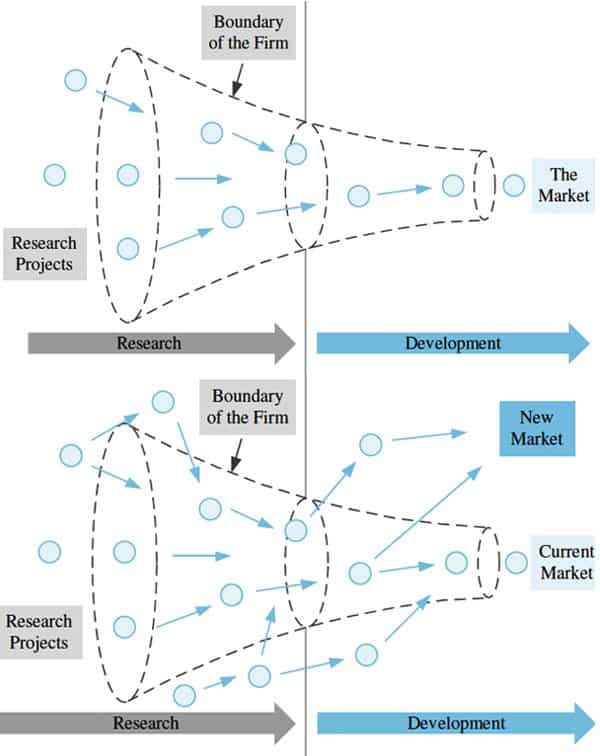
Open Innovation
Dr Henry Chesbrough, Executive Director, Center for Open Innovation, Haas School of Business, has introduced the open innovation model in his book Open Innovation: The New Imperative for Creating and Profiting from Technology as a transformation paradigm that companies should use external ideas as well as internal and external paths to develop new products. Both external and internal ideas flow to and within the company during the research stage to drive the innovation ecosystems inside the organisation. This model allows companies to develop new products that can be used to access new markets, such as Lego Ideas, which allows consumers to design new Lego sets that can have potential for new products in the market.
Innovation allows companies to achieve success by introducing new or improved products and services to the market. However, understanding the different types of innovation can help identify the suitable innovation model to adopt based on the company’s capabilities and market status. Earlier, we introduced different types of innovation based on the industry pattern, the term defined by the consumer, the market impact, and the source of innovation. One of the models is based on the impact of innovation and tends to categorize innovation as sustaining disruptive or breakthrough innovation. Most of these models depend on understanding the consumers’ needs and building a user-centred process, which ensures that the consumers’ needs or problems are solved by the innovative product.

